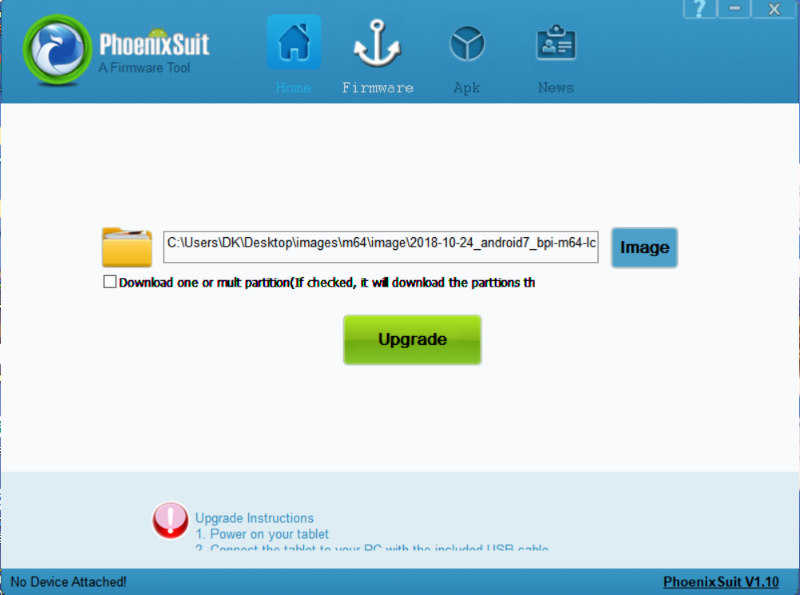
¶ Introduction
Banana Pi BPI-M64 is a 64-bit quad-core mini single board computer. It features 2GB of RAM and 8GB eMMC. It also has onboard WiFi and BT. On the ports side, the BPI-M64 has 2 USB A 2.0 ports, 1 USB OTG port, 1 HDMI port, 1 audio jack, and lastly a DC power port. The processor is pin-to-pin comptialbe with R18, so it comes with two versions:M64 and M64-R18.
| More Infomation: Banana Pi BPI-M64 |
¶ specifications
A64
-
1.2 Ghz Quad-Core ARM Cortex A53 64-Bit Processor-A64
-
2GB DDR3 SDRAM
-
8G EMMC
-
10/100/1000Mbps Ethernet
-
WiFi (AP6212) & Bluetooth
R18
-
1.2 Ghz Quad-Core ARM Cortex A53 64-Bit Processor-R18
-
2GB DDR3 SDRAM
-
8G EMMC
-
10/100/1000Mbps Ethernet
-
WiFi (AP6212) & Bluetooth
¶ Development
¶ Android
¶ Prepare
-
Prepare a USB-Serial cable, a MicroUSB cable and PC with Linux or WIndows 7/10
-
The USB-Serial cable is used for console debug and MicroUSB cable is used for Image download and ADB debug.
-
M64 board is only suport DC power supply bootup.
-
If you want insert a SDcard for Android storage using, and your SDcard was download Linux Image or any other allwinner bootable SDcard image, please format the SDcard start from block 0.
-
Download and Install Allwinner Image Download Tools, PhoenixSuit is for window and LiveSuit is for Linux
¶ Install Image with PhoenixSuit on Windows
-
Open PhoenixSuit, click the Firmware icon to switching to firmware download panel, then click Image button and choose the Android Image file.

-
M64 board disconnect DC power, press and hold the uboot-key button(new uart debug pin), plugin mirco-usb cable to PC, popup a warning dialog.
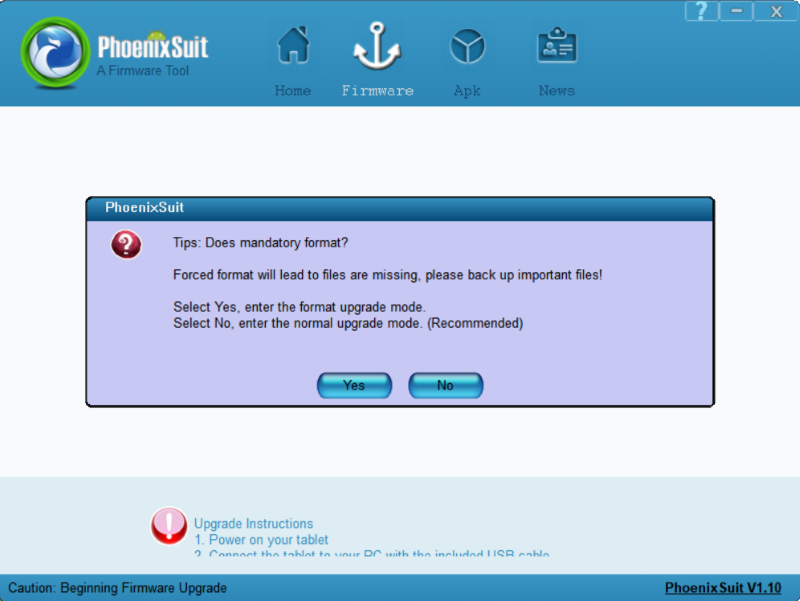
-
Press Yes to continue and popup another waring dialog, Press Yes to continue
-
Downloading
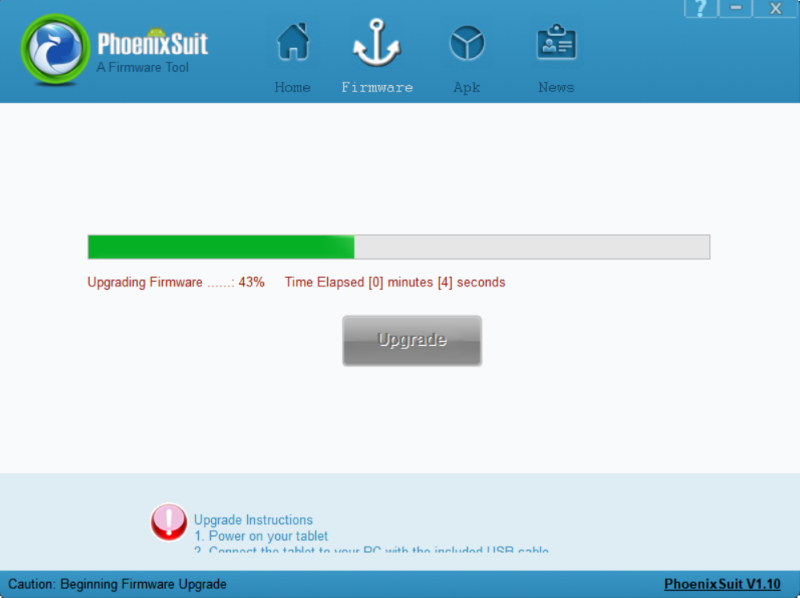
-
Download finish

¶ Install Image with LiveSuit on Linux
-
According to the Readme.pdf in LiveSuit Install package, After install the LiveSuit successfully please run LiveSuit.sh with root permission, then the download process is almost the same as PhoenixSuit.
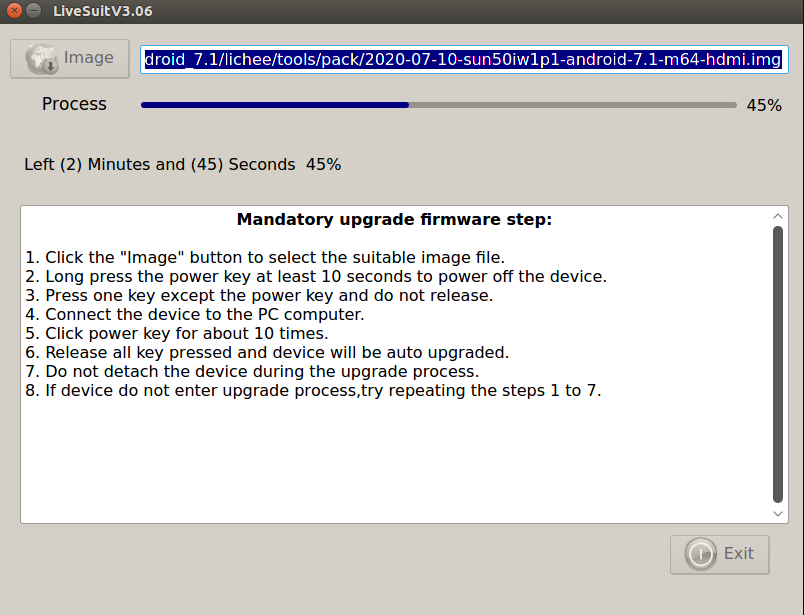
¶ Build Android source code
Get Android source code
-
Android 7.1
$ git clone https://github.com/BPI-SINOVOIP/BPI-A64-Android7 -
Android 6.1
$ git clone https://github.com/BPI-SINOVOIP/BPI-A64-Android
¶ Linux
¶ Prepare
-
Prepare 8G/above TF card, USB-Serial interface, PC with Ubuntu System
-
Using your USB-Serial Connect debug console on M64
-
M64 board is only suport DC power supply bootup
-
Install bpi-tools on your Linux PC. If you can’t access this URL or any other problems, please go to bpi-tools repo and install this tools manually.
$ apt-get install pv $ curl -sL https://github.com/BPI-SINOVOIP/bpi-tools/raw/master/bpi-tools | sudo -E bash -
Download BPI latest image
-
Login user/password: pi/bananapi or root/bananapi
¶ Install Image to SDcard
Windows PC
Install Image with Balena Etcher.
Balena Etcher is an opensource GUI flash tool by Balena, Flash OS images to SDcard or USB drive.
-
Click on "Flash from file" to select image.
-
Click on "Select target" to select USB device.
-
Click on "Flash!" Start burning.
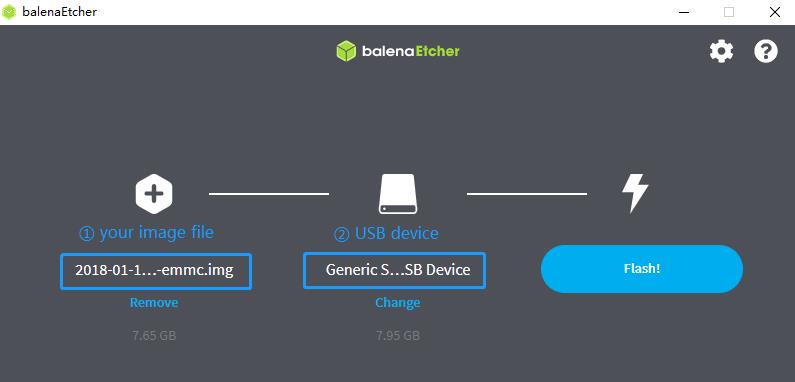
Linux PC
There are two methods for you to choose from.
-
Install Image with dd command on Linux, umount SDcard device /dev/sdX partition if mounted automatically. Actually bpi-copy is the same as this dd command.
$ sudo apt-get install pv unzip $ sudo unzip -p xxx-bpi-m64-xxx.img.zip | pv | dd of=/dev/sdX bs=10M status=noxfer -
Install image with bpi-tools on Linux, plug SDcard to Linux PC and run
$ sudo apt-get install pv unzip $ sudo bpi-copy xxx-bpi-m64-xxx.img.zip /dev/sdX
¶ Install Image to EMMC
-
Prepare a SDcard with Linux image flashed and bootup board with this SDcard.
-
Unzip the image and copy it to a USB drive, plug the udisk to board and mount it.(If automatically mounted, ignore this step)
mount /dev/sdx /mnt -
There are two ways to install the linux image to board.
-
Install with dd command.
sudo dd if=/mnt/xxx.bpi-p2_zero-xxx.img of=/dev/mmcblk0 bs=10M status=noxfer -
Install the linux image in udisk with bpi-tools command
$ sudo bpi-copy xxx-bpi-p2_zero-xxx.img.zip /dev/mmcblk0
-
-
After download complete, power off safely and eject the SDcard.
¶ Switch to LCD boot type
-
The default release images are HDMI boot type, you can switch to LCD boot type for BPI 7" LCD support after first boot.
$ sudo bpi-bootsel /usr/lib/u-boot/bananapi/bpi-m64/BPI-M64-LCD7-linux4.4-8k.img.gz $ reboot -
Load the Touchscreen driver if you want to using TP
$ sudo modprobe gt9xxnew_ts.ko
¶ Build Linux source code
Get the bsp source code
$ git clone https://github.com/BPI-SINOVOIP/BPI-M64-bsp-4.4¶ Other development
¶ GMAC
Use iperf3 to test gmac
-
On PC Terminal:
-
Execute
iperf3 -s
-
-
On M2U console:
-
TCP test:
iperf3 -c serverIP -
UDP test:
iperf3 -u -c serverIP
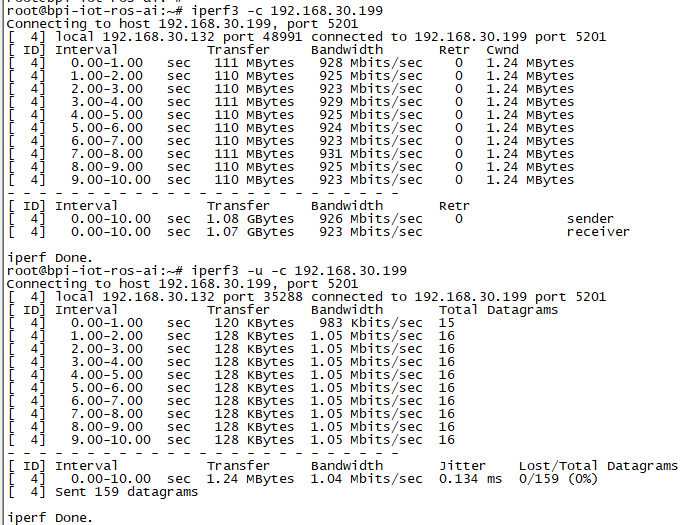
-
¶ Bluetooth
-
Use bluetoothctl tool to operate BT
-
Execute
bluetoothctl -
If you don’t know how to use bluetoothctl, type "help", you will see more commands
-
Execute these commands:

¶ WiFi
¶ WiFi Client
You have two ways to setup WiFi Client
-
Use commands to setup WiFi client
ip link set wlan0 up iw dev wlan0 scan | grep SSID vim /etc/wpasupplicant/wpa_supplicant.confnetwork={ ssid="ssid" psk="password" priority=1 }wpa_supplicant -iwlan0 -c /etc/wpa_supplicant/wpa_supplicant.conf dhclient wlan0 -
Use UI interface to setup WiFi Client
¶ Ap Mode
-
Install hostapd and create hostapd configuration file hostapd.conf:
interface=wlan0 driver=nl80211 ssid=test hw_mode=g channel=1 -
Execute command
hostapd -d /<path>/hostapd.conf-
If you meet problem like this:
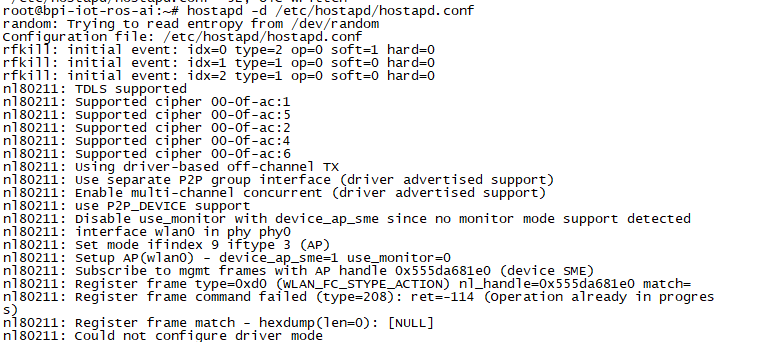
-
Then, you could solve by following command:
nmcli radio wifi off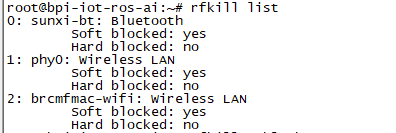
rfkill unblock 1 rfkill unblock 2 ifconfig wlan0 up hostapd -d hostapd.conf
-
¶ Clear boot
git clone https://github.com/BPI-SINOVOIP/BPI-files/tree/master/SD/100MB
bpi-bootsel BPI-cleanboot-8k.img.gz /dev/sdX¶ GPIO Control
-
To access a GPIO pin you first need to export it with
echo XX > /sys/class/gpio/export -
with XX being the number of the desired pin. To obtain the correct number you have to calculate it from the pin name (like PH18)
(position of letter in alphabet - 1) * 32 + pin number
for PH18 this would be ( 8 - 1) * 32 + 18 = 224 + 18 = 242 (since 'h' is the 8th letter)echo "out/in" > /sys/class/gpio/gpio*NUMBER*/direction echo "0/1" > /sys/class/gpio/gpio*NUMBER*/value
¶ Camara function
We use HDF5640 camara.
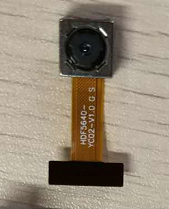
Guvcview
Use your UI interface to operate camara
Applications → Sound & Video → guvcview
Shell
We also have built-in command in "/usr/local/bin" to test camara
-
Test picture taking function
./test_ov5640_image_mode.sh -
Test video recording function
./cameratest.sh
IR function
-
Execute
getevent -
Use your IR device to send information to A64
¶ RPi.GPIO
Install RPi.GPIO
git clone https://github.com/BPI-SINOVOIP/RPi.GPIO
cd RPi.GPIO
sudo apt-get update
sudo apt-get install python-dev python3-devExecute
sudo python setup.py installor
sudo python3 setup.py installUsing RPi.GPIO
cd /usr/local/bin
./bpi_test_g40.py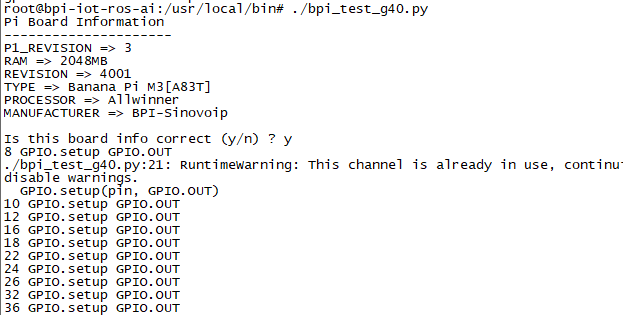
¶ WiringPi
We also have built-in test command in
/usr/local/binHow to Update WiringPi
bpi-update -c pkglist.conf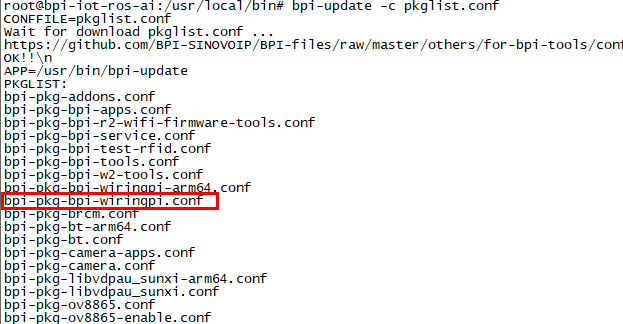
bpi-update -c bpi-pkg-bpi-wiringpi.conf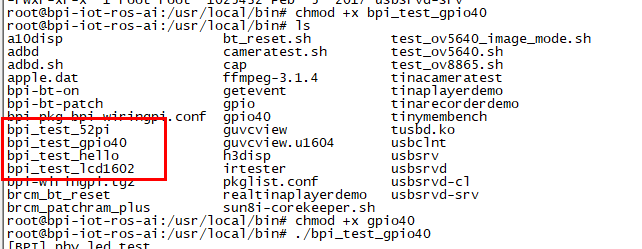
RGB 1602 LCD
/usr/local/bin/bpi_test_lcd1602.sh0.96 Inch OLED Display
/usr/local/bin/bpi_test_52pi.sh8x8 RGB LED Martix
Firstly you need a GPIO Extend Board for 8x8 LED Martix
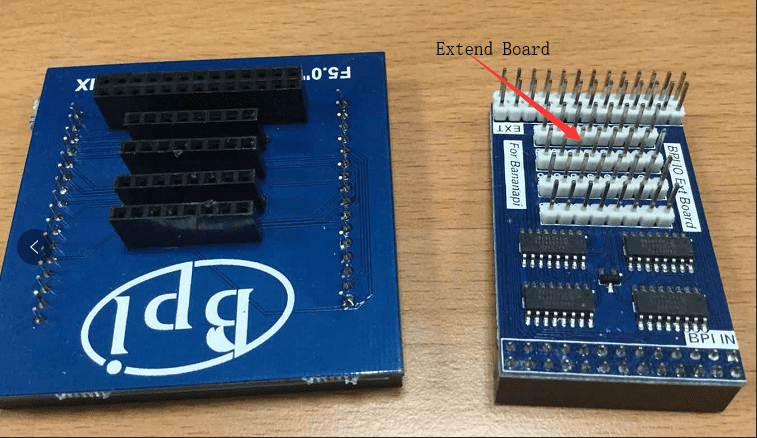
/usr/local/bin/bpi_test_gpio40.sh